The Substrate-like PCB Market is estimated to be valued at USD 2.1 billion in 2025 and is projected to reach USD 6.9 billion by 2035, registering a compound annual growth rate (CAGR) of 12.9% over the forecast period.
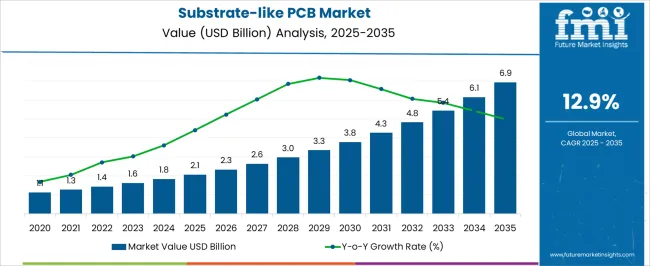
| Metric | Value |
|---|---|
| Substrate-like PCB Market Estimated Value in (2025 E) | USD 2.1 billion |
| Substrate-like PCB Market Forecast Value in (2035 F) | USD 6.9 billion |
| Forecast CAGR (2025 to 2035) | 12.9% |
The substrate like PCB market is experiencing strong momentum driven by advancements in miniaturization, high density interconnect demand, and the proliferation of next generation consumer electronics. Growing adoption of 5G, advanced smartphones, and high performance computing devices has significantly increased the requirement for finer line width and spacing to support complex circuit integration.
Continuous innovation in inspection technologies and stringent quality standards in manufacturing are further supporting the expansion of the market. The sector is also benefiting from increasing investments in semiconductor packaging and the rapid evolution of automotive electronics, particularly in electric and autonomous vehicles.
The overall outlook remains positive as consumer and industrial demand continues to rise, encouraging manufacturers to adopt substrate like PCB technologies to achieve high performance, reliability, and scalability across diverse applications.
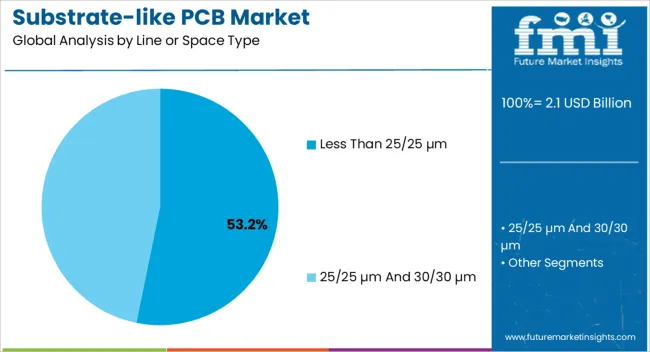
The less than 25/25 µm line or space type segment is projected to account for 53.20% of total revenue by 2025, making it the dominant line or space category. This growth is being driven by the increasing need for ultra fine circuitry that supports compact device designs, faster data transfer, and higher functionality.
Demand for high density interconnect technology in mobile devices, wearables, and next generation computing platforms has reinforced the adoption of this segment.
The ability to provide improved electrical performance and superior signal integrity further strengthens its market leadership, positioning it as the preferred line or space type in substrate like PCB manufacturing.
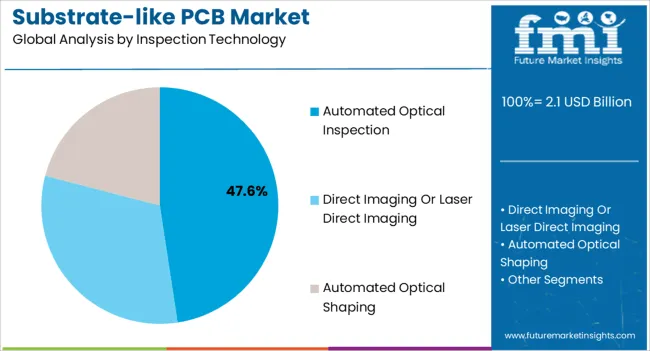
The automated optical inspection technology segment is anticipated to hold 47.60% of market revenue by 2025 within the inspection technology category, establishing it as the leading segment. This position is attributed to its ability to deliver real time defect detection, enhance manufacturing precision, and reduce production costs by minimizing rework.
Automated systems improve efficiency by quickly identifying micro level faults in circuit patterns, which is essential in advanced packaging and high density designs.
As electronic components continue to shrink in size and increase in complexity, reliance on automated optical inspection has grown, ensuring quality compliance and high yield in mass production environments.
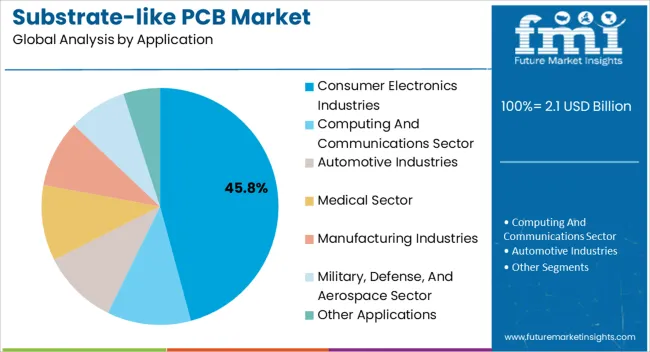
The consumer electronics industries application segment is expected to contribute 45.80% of total revenue by 2025, securing its role as the dominant application area. This is driven by the rapid growth of smartphones, tablets, laptops, and wearable devices that demand compact and high performance circuitry.
Consumer preferences for multifunctional devices with extended battery life and enhanced processing capabilities have accelerated the adoption of substrate like PCBs. Continuous innovation in consumer technology, combined with mass production and global supply chain expansion, has reinforced the segment’s leadership.
The increasing penetration of 5G and smart home devices further supports this trend, positioning consumer electronics industries as the key growth driver for substrate like PCB applications.
By the end of the year 2020, the net valuation of the market was figured out by FMI to be around USD 1.1 billion. The 15.9% CAGR displayed that the market's average annual growth rate over the specified time frame from 2020 to 2025 was at its peak.
Stiff-flex PCBs can be expensive which can limit their sales for some years, as they require complicated manufacturing processes as compared to typical rigid PCBs. Beyond IoT and automotive electronics, rigid-flex PCBs are also anticipated to become widespread as technology develops and consumer demand for reliable electronics rises.
Rigid-flex PCBs have acquired a lot of interest in the design of IoT devices in the last few years due to their great endurance. These flexible wiring-connected printed circuit boards (PCBs) provide benefits over conventional rigid PCBs, particularly in high-vibration situations like automotive engines. So the automotive sector has increased its use creating a huge potential for this segment in recent years.
| Top Line or Space Type Segment | 25/25 µm and 30/30 µm Line or Space |
|---|---|
| Top Market Segment Historical CAGR from 2020 to 2025 | 15.7% |
| Top Market Segment Forecasted CAGR from 2025 to 2035 | 13.4% |
Growing focus on the 25/25 µm and 30/30 µm market segments in recent years has been highlighted by FMI experts in the report. By the conclusion of the analysis period, it is anticipated that this segment could dominate the overall market by following a high growth rate.
The automated optical inspection technology segment is anticipated to represent a sizable potential for the market growing at a high rate than other segments. Due to its ease of application and comparatively low operational cost, it is predicted to remain the preferred choice among end-users through 2035.
| Top Inspection Technology Segment | Automated Optical Inspection |
|---|---|
| Top Market Segment Historical CAGR from 2020 to 2025 | 15.5% |
| Top Market Segment Forecasted CAGR from 2025 to 2035 | 13.3% |
| Regional Market Attributes | Details |
|---|---|
| Historical CAGR of the United States Market from 2020 to 2025 | 12.6% |
| Forecasted CAGR of the United States Market from 2025 to 2035 | 12.3% |
| Anticipated Overall Market Value in the United States by 2035 | USD 852.9 million |
| The United States Market Absolute Dollar Growth Until 2035 | USD 585.5 million |
The demand for substrate-like PCBs in the United States is huge, and the market is anticipated to expand steadily due to evolving technology. Furthermore, the rising demand for high-performance electronics and the existence of key competitors in the country could play a crucial role in this progress. Although sales in the domestic market could expand at a pace of 12.3%, manufacturers hope to find great opportunities beyond the United States.
| Regional Market Attributes | Details |
|---|---|
| Historical CAGR of the United Kingdom Market from 2020 to 2025 | 11.1% |
| Forecasted CAGR of the United Kingdom Market from 2025 to 2035 | 11.9% |
| Anticipated Overall Market Value in the United Kingdom by 2035 | USD 142.6 million |
| Projected Growth of the Market Until 2035 in Absolute Dollar | USD 96.2 million |
The establishment of new PCB manufacturing facilities in Europe is a response to the expanding demand for circuit boards of superior quality. Germany, France, Spain, and the United Kingdom are mentioned as notable regional markets for substrate-like PCBs in Europe. The United Kingdom is also anticipated to expand at a slightly significant pace from 2025 to 2035 suggesting a promising market for manufacturers in Europe.
| Regional Market Attributes | Details |
|---|---|
| Historical CAGR of the China Market from 2020 to 2025 | 18.1% |
| Forecasted CAGR of the China Market from 2025 to 2035 | 15.1% |
| Anticipated Overall Market Value in China by 2035 | USD 1.5 billion |
| China Market Absolute Dollar Growth until 2035 | USD 1.1 billion |
Many Asia Pacific countries contribute significantly to the global PCB industry and also held a considerable share in this substrate-like PCB industry. Key participants in this geographical region include China, Japan, South Korea, India, and Taiwan as well as some South East Asian Association countries. Further, China holds strong PCB manufacturing capacities, which are projected to be fueled by the region's emphasis on technical improvements and production capacities.
| Regional Market Attributes | Details |
|---|---|
| Historical CAGR of the Japan Market from 2020 to 2025 | 17% |
| Forecasted CAGR of the Japan Market from 2025 to 2035 | 13.8% |
| Anticipated Overall Market Value in Japan by 2035 | USD 1 billion |
| Japan Market Absolute Dollar Growth Until 2035 | USD 726 million |
India is emerging as a significant center for electronics production, including substrate-like PCBs, due to its trained labor, welcoming business environment, and supportive infrastructure. In contrast, the state of the economy, changes in regulations, and industry competitiveness can have an impact on the market dynamics of other regional countries.
AT&S AG, which produces high-tech PCBs for a range of medical applications, said in January 2025 to expand its manufacturing facility in Asia Pacific. Asia Pacific PCB manufacturers now have great access to chips and this expansion guarantees its development in the Southeast Asian medical devices sector.
| Regional Market Attributes | Details |
|---|---|
| Historical CAGR of the South Korea Market from 2020 to 2025 | 17.4% |
| Forecasted CAGR of the South Korea Market from 2025 to 2035 | 14% |
| Anticipated Overall Market Value in South Korea by 2035 | USD 357.7 million |
| South Korea Market Absolute Dollar Growth Until 2035 | USD 261.3 million |
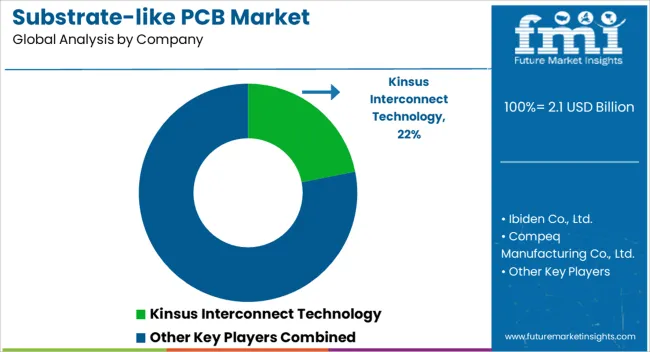
Manufacturers’ response to rising worries about cutting-edge technology, the robustness of the PCB supply chain, and geographical diversity influence the overall market competitive landscape. Moreover, opening highly automated printed circuit board (PCB) production facilities by many leading market players demonstrates their dedication to cutting-edge technology. For instance,
Leading players hope to remain competitive in the developing electronics market and fulfill the rising demand for complex circuit boards by making high-tech investments. They are also putting a huge emphasis on increasing the resilience of the PCB supply chain after the recent pandemic disruptions. Furthermore, recent geopolitical issues have highlighted how crucial it is to diversify production sites leading to frequent mergers and partnerships with regional players.
How can Substrate-like PCB Manufacturers Scale their Businesses in the Global Market?
The substrate-like printed circuit board (PCB) manufacturers can adopt ongoing innovation and product development initiatives to scale up their businesses. By extending production facilities to emerging economies, manufacturers can reduce any risks and can make sure that their goods have a reliable supply chain.
Existing players as well as start-ups can adopt industrial automation systems to increase the production capacity of their facilities. Moreover, automation increases productivity, accuracy, and scalability, enabling the manufacture of high-quality substrate-like printed circuit boards (PCBs). New players can also take advantage of access to a large talent pool and fortify their position by utilizing the benefits of e-commerce platforms.
Key Players Profiled in the Substrate-like PCB Market Report
| Attribute | Details |
|---|---|
| Forecast Period | 2025 to 2035 |
| Historical Data Available for | 2020 to 2025 |
| Market Analysis | USD million or USD billion for Value and Units for Volume |
| Key Regions Covered | North America; Latin America; Europe; The Middle East & Africa; East Asia; South Asia and Oceania |
| Key Countries Covered | The United States, Canada, Brazil, Mexico, Germany, Spain, Italy, France, United Kingdom, Russia, China, India, Australia & New Zealand, GCC Countries, and South Africa |
| Key Segments Covered | By Line or Space Type, By Inspection Technology, By Application, and By Region |
| Key Companies Profiled | Kinsus Interconnect Technology; Ibiden Co.; Ltd.; Compaq Manufacturing Co.; Ltd.; Unimicron Technology Corporation; Austria Technologie & Systemtechnik AG (AT&S); TTM Technologies; Samsung Electro-Mechanics; Korea International Circuit Incorporation; Zhen Ding Technology; Daeduck Gds Company; and Tripod Technology Corp |
| Report Coverage | Market Forecast, Company Share Analysis, Competition Intelligence, DROT Analysis, Market Dynamics and Challenges, and Strategic Growth Initiatives |
| Customization & Pricing | Available upon Request |
The global substrate-like PCB market is estimated to be valued at USD 2.1 billion in 2025.
The market size for the substrate-like PCB market is projected to reach USD 6.9 billion by 2035.
The substrate-like PCB market is expected to grow at a 12.9% CAGR between 2025 and 2035.
The key product types in substrate-like PCB market are less than 25/25 µm and 25/25 µm and 30/30 µm.
In terms of inspection technology, automated optical inspection segment to command 47.6% share in the substrate-like PCB market in 2025.






Full Research Suite comprises of:
Market outlook & trends analysis
Interviews & case studies
Strategic recommendations
Vendor profiles & capabilities analysis
5-year forecasts
8 regions and 60+ country-level data splits
Market segment data splits
12 months of continuous data updates
DELIVERED AS:
PDF EXCEL ONLINE
PCB Connector Market Size and Share Forecast Outlook 2025 to 2035
PCB Design Software Market Analysis by Component, Deployment, Application, and Region Through 2035
PCB Design Software Industry in Europe – Growth & Forecast 2023-2033
Multi-Axis PCB Drilling Machine Market Size and Share Forecast Outlook 2025 to 2035
Rigid-Flex PCB Market Size and Share Forecast Outlook 2025 to 2035
Printed Circuit Board (PCB) Assembly Market Size and Share Forecast Outlook 2025 to 2035
Printed Circuit Boards (PCB) Market Trends - Demand & Forecast 2025 to 2035

Thank you!
You will receive an email from our Business Development Manager. Please be sure to check your SPAM/JUNK folder too.
Chat With
MaRIA